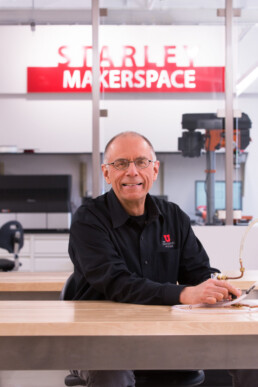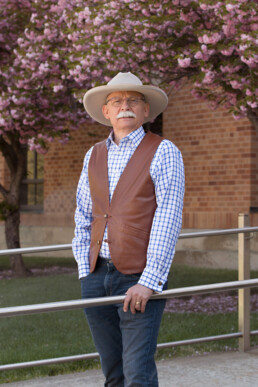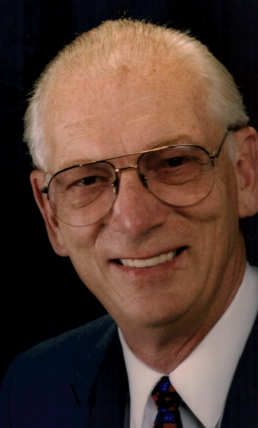Saying Goodbye
This year, the University of Utah’s Department of Chemical Engineering is saying goodbye to three longtime esteemed faculty members who are well known as researchers, respected educators, and department administrators.
Geoffrey D. Silcox
Professor (lecturer) Geoffrey D. Silcox, a department associate chair who has been with the U for more than 30 years, is retiring at the end of this year.
“I’ve had wonderful colleagues and have enjoyed teaching and working with students,” he said. “I am also fortunate to know that I am leaving my positions as associate chair and as chair of the undergraduate committee in the hands of someone who will do an outstanding job, Prof. Tony Butterfield.”
Silcox received his bachelor’s in chemistry and a doctorate in chemical engineering, both from the University of Utah. He worked as a chemist for the Salt Lake City office of the Occupational Safety and Health Administration and was an engineer for the Energy and Environmental Research Corp., in California before arriving at the U in 1987. He was a research associate professor in 1993, an associate professor (clinical) in 1997 and named the department’s associate chair in 2000. He became associate professor (lecturer) in 2000 and professor (lecturer) in 2003.
Classes he has taught have included Design and Innovation in Chemical Engineering, Thermodynamics I, Statistics for Chemical Engineers, and Fundamentals of Process Engineering.
During his tenure in the department, he was also undergraduate advisor, chair of the Undergraduate Committee and director of the Great Salt Lake Section of AIChE. His research interests include controlling and characterizing the emissions of pollutants from the combustion of low-quality fuels, air pollution, air quality, and process modeling.
Philip J. Smith
Meanwhile, University of Utah chemical engineering professor Philip J. Smith, a former chair of the chemical engineering department who was also the director of the Institute for Clean and Secure Energy, retired this last summer.
Smith earned bachelor’s degrees in chemical engineering and in physics, and master’s and doctorate degrees in chemical engineering, all from Brigham Young University. Before joining the U, he was an assistant and associate professor at BYU, a staff member with the Los Alamos National Laboratory and co-founder and vice president of Reaction Engineering International.
“I left the BYU faculty of Chemical Engineering to become a Ute in 1990. It was the best professional decision of my career. I am honored to have been able to have spent 32 years as a faculty member in the Department of Chemical Engineering at The University of Utah,” Smith said. “As a young student graduating with a double major in Physics and Chemical Engineering, I discovered that engineering, the application of science in the service of mankind, is the noble profession I had always wanted.”
He joined the U as a professor in 1990 and was named chair of the department from 2000 to 2007. As a professor, he supervised 16 postdoctoral fellows, 33 Ph.D. students, and 13 master’s students. He was also director of the Utah Heavy Oil Center, associate director for the Center for Simulation of Accidental Fires and Explosions, and director of the Carbon Capture Multidisciplinary Simulation Center. He is also president of CRSim Inc., a University of Utah spinoff company.
His research interests included artificial intelligence and digital twinning for industrial combustion applications; uncertainty quantification, verification and validation in simulation science; combustion and fire simulation and modeling with high-performance computing; and coal combustion and gasification.
A. Lamont Tyler
On a sadder note, earlier this year the department also lost A. Lamont Tyler, a beloved former professor of chemical engineering at the University of Utah who was chair of the department for 13 years and a former member of the Utah Legislature. Tyler passed away May 8 in his Millcreek, Utah, home after a brief illness. He was 85.
He attended the University of Utah’s College of Engineering where he earned a bachelor’s in 1961 and a doctorate degree in 1965, both in chemical engineering.
During and after college, Tyler worked for a range of companies, including Westinghouse Electric Corp. in Idaho Falls, Hercules Powder Company in Salt Lake City, Bell Telephone Laboratories in Pennsylvania, and Lawrence Livermore Laboratories in California.
Tyler joined the University of Utah in 1970, first as an assistant professor of chemical engineering and was named associate professor in 1978. He was named a full professor in 1983. He was chair of the U’s Department of Chemical Engineering from 1981 to 1994. After retiring, he taught classes at Salt Lake Community College from 2005 until his death in subjects ranging from algebra to chemical engineering courses such as “Material and Energy Balances.”
Tyler’s research focused on the study of oil shales, heavy oil and catalytic cracking. He was a co-developer of a staged low-profile fluidized catalytic cracker (LP-FCC) technology and spearheaded the development and construction of pilot-scale LP-FCC unit, operated at the University of Utah’s off-campus energy research lab.


